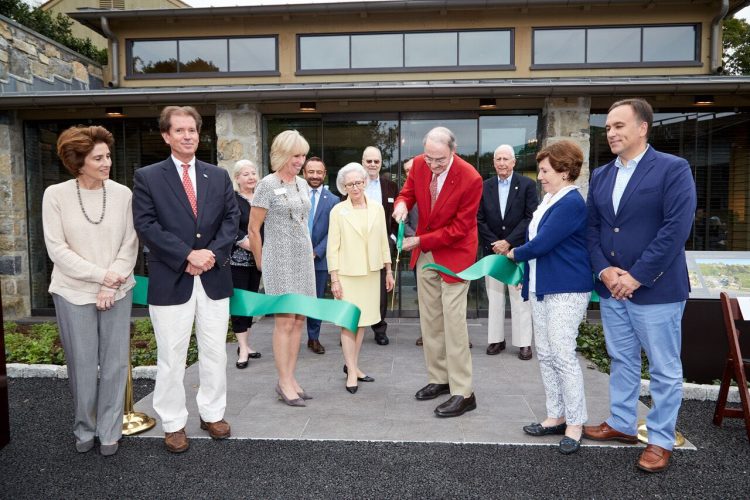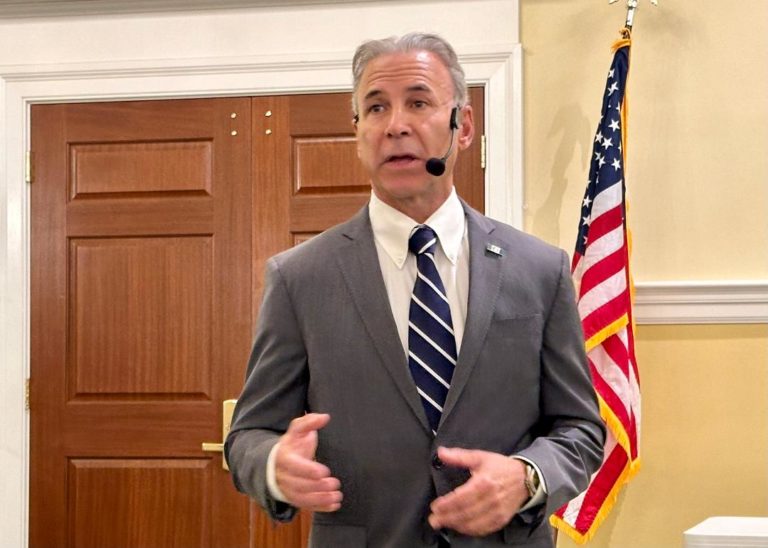

By Richard Kaufman
It’s often said that history is one of life’s greatest teachers. From now on, those who visit the Greenwich Historical Society’s (GHS) brand new campus will be enriched and educated for years to come.
Last Saturday, the Greenwich community gathered just off Strickland Road in Cos Cob for the ribbon-cutting ceremony which officially unveiled the reimagined GHS campus. Afterwards, attendees toured the grounds, enjoyed live music, arts and crafts, games and food trucks.
The transformed campus, which has expanded parking and complete ADA access, features state-of-the-art museum galleries, an accessible library and archives, cafe, gift shop and restored Impressionist-era gardens.
The campus allows the GHS to display more collections and programming to help people better understand the significant role Greenwich played in opening up the gateway to New England.
The inaugural exhibition at the new campus is titled, “History Is…” and encourages visitors to reflect on the role history plays at different stages in their lives and explores the ways individuals look at, define and interpret history.
Those in attendance on Saturday were thrust back into the 1800’s, as an organ grinder played music before the ribbon-cutting ceremony. Davidde Strackbein, chair of the Board of Trustees for the Historical Society, said the new campus represents what the GHS, founded in 1931, is all about.
“We’ve made a bit of history of our own by reimagining the campus while remaining true to our original charter mission: to collect, persevere and share the history of the town of Greenwich,” Strackbein said, noting that the foundation has been set for another successful chapter for the GHS.
“[We want to] contribute to creating a stronger, more unified future for our children and community, [while] embracing a shared history, a shared history that defines us, inspires us, and unites us.”
Cynthia Malkin Blumenthal, wife of U.S. Senator, Richard Blumenthal, who are both honorary chairs of the Reimagine the Campus Capital Campaign, presented a proclamation to the GHS. She spoke of her love of history, and quoted the esteemed historian, David McCullough:
“‘History is a guide to navigation in perilous times. History is who we are, and why we are the way we are. You cannot be a full participant in our democracy if you don’t know our history,’”she said.
State Sen., Scott Frantz, also an honorary chair, called the new campus a “home run,” and compared it to the living museum in Old Sturbridge Village in Sturbridge, Mass.
“It’s an amazing structure. It’s an amazing building from the outside, any way you look at it,” he said.
First Selectman, Peter Tesei, said the new campus is a “treasure” for the town, and that it will serve as a great learning tool to Greenwich’s youngest citizens.
“History is our greatest teacher, and those of us who serve today, those of us who have served previously, all rely upon the history to teach us the values and beliefs of what this community was about and is about, and its future,” he said. “The resources that are now available to us as citizens, particularly our youngest citizens, is just unbelievable.”

Peter Malkin, chair of the Reimagine the Campus Capital Campaign Committee, and a longtime supporter of the GHS, noted that the project renovation, which was privately funded, was completed a year ahead of schedule and slightly under budget.
The $20 million capital campaign has exceeded the $13.5 million goal that was needed for the campus renovation and the programing initiatives. The balance still to be raised will fund the Historical Society’s endowment, which will be used to cover operational costs and support programs and partnerships with Hamilton Avenue School and other schools in town.
After the bright green ribbon was cut, excited guests got a first look at the campus. Several gathered in the cafe dining area, which was once the lobby of the Railroad House Hotel, built in 1855, after the railroad came to town in 1848. The hotel served many New Yorkers who were looking to escape the city in the summer. The hotel subsequently became Toby’s Tavern.
The wallpaper in the cafe dining area matches the original design. David Scott Parker Architects, who spearheaded the design of the new campus, uncovered a portion of the wallpaper and later matched it with boards that were removed from the wall and stored upstairs to complete the repeat design.

The campus is, of course, home to the National Historic Landmark, Bush-Holley House (circa 1730), which played an important role as one of the earliest American Impressionist art colonies.
Guests are able view the Impressionist-era gardens from the second floor gallery of the museum, which features many paintings that depict the grounds surrounding the campus. It gives guests a unique experience into how Impressionism in America originated and how Greenwich is tied to the history of the country as a whole.
“The artists lived here, they painted here, and they painted what they saw here. You’ll see these buildings in their paintings, then when you look out the window you can see what they saw,” said David Scott Parker. “The people and the place and the art are all part of one another.”
Parker said designing the campus was a coordinated effort, but it was complicated because of all the different agencies he had to work with, such as the Department of Transportation, since the Historical Society is right under I-95.
He said the official opening of the campus was “thrilling,” especially since it came a year ahead of schedule.
“The best thing is really how happy it makes people who come to see it. Things like this are all about people. History is something we learn from, but something we’re very much apart of. This is part of the history of Greenwich,” Parker said.




